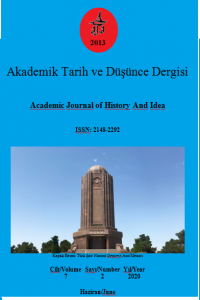Nureddin Mahmud’un Haçlılar ve Bizans Devleti ile Münasebetleri
Zengiler, hanedanlığının temelleri Musul
ve Halep merkez olmak üzere, İmadeddin Zengi tarafından atılmıştır. Zengiler,
başlangıçta Büyük Selçuklu Devleti’ne tabi iken daha sonraki süreçte
Selçuklular’ın zayıflaması ile bağımsız hareket etmeye başlamıştır. İmadeddin
Zengi, sadece Musul Atabeyliğinin kurucusu olması dolayısıyla değil, aynı
zamanda Haçlılar ile yapmış olduğu mücadele dolayısıyla da önemli bir yere
sahiptir. Bilindiği üzere I. Haçlı seferi sonrası Anadolu’da bir çok haçlı
kontluğu kurulmuştur. Bunların en önemlilerinden birisi de Urfa Haçlı
Kontluğu’dur. Urfa, stratejik açıdan oldukça önemli bir bölgeydi. Bu bölgenin,
haçlıların eline geçmesi, bölgeye gelen Türkmen akınlarının da önünü kesmiştir.
İmadeddin Zengi, 1144 tarihinde Urfa’yı yeniden fethetmeyi başarmıştır.
Müslüman aleminde büyük bir sevinç yaşanmasını sağlayan bu olay, batıda ise hem
üzüntü hem de korku ile karşılanmıştır. Urfa’dan sonra sıranın Antalya ve
Kudüs’e geleceğini düşünen Haçlılar, ikinci bir sefer daha düzenlemişlerdir. II.
Haçlı Seferi öncesi Caber Kalesi kuşatması esnasında hayatını kaybeden
İmadeddin Zengi’nin yerini oğulları, Seyfeddin Gazi ve Nureddin Mahmud b. Zengi
paylaşmışlardır. Seyfeddin Gazinin merkezi Musul, Nureddin Mahmud b. Zengi’nin
merkezi ise Halep ve çevresidir. Nureddin, Türk-İslam birliğini
gerçekleştirebilmek için çok ciddi bir çaba harcamıştır. Gerek II. Haçlı Seferi
esnasında, gerekse II. Haçlı Seferi sonrasında haçlılara karşı büyük darbeler
indirmiştir. Haçlılar ile mücadelede Türk-İslam dünyasının başarı kazanabilmesi
için kendi düşmanları ile ittifak yapmaktan dahi çekinmemiştir. Bu çalışmada
Nureddin Mahmud b. Zengi’nin Haçlılar ve Bizans Devleti ile münasebetleri
incelenmiştir.
Anahtar Kelimeler:
Nureddin Mahmud b. Zengi, Haçlılar, II. Haçlı Seferi
The Relatıons of Nureddın Mahmud Wıth the Crusaders and the Byzantıne State
The
foundations of the Zengi dynasty were laid by Imadeddin Zengi, with Mosul and
Aleppo being the center. While the zengis were initially subordinate to the
Great Seljuk state, they began to act independently in the later period with
the weakening of the Seljuks. Imadeddin Zengi has an important place not only
because he was the founder of the Atabeylig of the Mosul, but also because of
his struggle with the Crusaders. As it is known, after the I. crusade, many
crusader counties were established in Anatolia. One of the most important of
these is the Crusader County of Urfa. Urfa was a strategically important region.
The fact that this region was taken by the Crusaders also prevented the Turkmen
incursions into the region. Imadeddin Zengi succeeded in reconquering Urfa in
1144. This event, which caused great joy in the Muslim world, was met with both
sadness and fear in the West. After Urfa, the Crusaders organized a second
expedition cause they thought that the queue would come to Antalya and
Jerusalem. Imadeddin Zengi was replaced by his sons, Seyfeddin Gazi and
Nureddin Mahmud b. Zengi who died during the siege of Caber Castle before the
II. Crusade.Seyfeddin Gazi's headquarter is Mosul, Nureddin Mahmud b. Zengi's
headquarter is Aleppo and its surroundings. Nureddin made a very serious effort
in order to achieve the Turkish-Islamic Union. He dealt major blows to the Crusaders
both during the II. Crusade and after the II.Crusade. He did not hesitate to
ally himself with his enemies in order for the Turkish-Islamic world to gain
success in the fight against the Crusaders. In this article Nureddin Mahmud B.
Zengi's relations with the Crusaders and the Byzantine State will be examined.
Keywords:
: Nureddin Mahmud B. Zengi, Crusaders, II. Crusade,
___
- DEMİRKENT, I.,Haçlı Seferleri Tarihi,İstanbul: Dünya Kitapları, 2007. DEMİRKENT,I.,Urfa Haçlı Kontluğu Tarihi (1098-1118),II, Ankara: Türk Tarih Kurumu Yayınları, 1994. EBU ŞÂME, Kitâbu’r-Ravdateyn Fî Ahbâri’d-Devleteyn En-Nuriye Ve’s- Selâhiyye, I, Kahire 1956. EĞİLMEZ, M., “Musul ve Halep Atabeyi Nureddin Mahmud”, Türkler Ansiklopedisi,IV:825-835, Ankara: Yeni Türkiye Yayınları, 2002. ELİSSEEFF, N.,Nur Ad-Din Un Grand Prince Musulman De Syrie Au Temps Des Croisades (511-568/1118-1174),II, Dımaşk 1967. ERSAN, M., “Bizans İmparatorluğu-Antakya Haçlı Prinkepsliği Siyasi İlişkilerine Bir Bakış”, 335-346, Prof. Dr. Işın Demirkent Anısına, İstanbul: Dünya Yayınları, 2008. ERSAN, M.,Selçuklular Zamanında Anadolu’da Ermeniler, Türk Tarih Kurumu, Ankara 2007. GİBB, H.A.R., “The Career of Nur-ad-din”, A History of the Crusades, First Hundred Years, ed. Kenneth M. Setton, 513-528, Madison:University of Wisconsin, 1969. GREGORY ABÛ’L-FARAC, Abû’l Farac Tarihi, II, çev. Ömer Rıza Doğrul, Ankara: Türk Tarih Kurumu Yayınları, 1999.
- Yayın Aralığı: Yılda 6 Sayı
- Başlangıç: 2013
- Yayıncı: Hakan YILMAZ
Sayıdaki Diğer Makaleler
İki İstiklal Madalyalı Kahraman: Müftü Ahmet İzzet Çalgüner (1875-1952)
Kanunî Devri’nde Bir Serhad Şehri Olarak Bayburt
Nureddin Mahmud’un Haçlılar ve Bizans Devleti ile Münasebetleri
Derleme Sözlüğü İle Tarama Sözlüğü’ndeki Bitki Adlarının Karşılaştırılması
Milli Aşireti Reisi 41. Hamidiye Alayı Komutanı İbrahim Paşa’n ın Yemen’e Gönderilme Teşebbüsü
Fiqh elminin metodologiyası və hədisşünaslıqla olan əlaqəsi (Şiə məzhəbi kontekstində)
Seyf-i Fergânî’nin Şiirlerindeki Sanatlar
Sovyetler Birliği’nde Kadının Konumuna Genel Bakış
